I've got a copy of a figure that needs error bars added to it. My data is coming from one CSV file and I've tried separating this into 4 distinct, workable sections for 4 depth profiles (ligand and logK; station 5 and station 9). The following code is for one of these profiles in hopes that I'll be able to recreate this solution 3 more times. Right now, my code looks like this, where I've read in a CSV file, transformed it from wide to long, and plotted using the ggplot function. However, I'm having trouble visualizing how to add horizontal error bars without ggplot thinking the columns for error bars are actual points I want to plot on the graph. I have a feeling it has something to do with my data wrangling in the beginning, but I'm not sure what. (Note: this is my first post here, so if it's not an actual reprex, please let me know!! I tried my best to be clear, but if it's not I will try and amend).
What I have so far...without error bars
Note: the actual plot I have has many of the aesthetics adjusted as well, but to try and cut down on code, I left those lines out.
Figure with error bar data plotted as points on the graph
This figure has an adjusted line for gather() function where the error columns are included as a part of the measurement column of the long data; listed below for reference
station5_L1_long <- gather(station5_L1, col_names, measurement, dFe:L1_diff_from_mean, factor_key=TRUE)
Figure with adjusted aesthetics
library(ggplot2) #using the ggplot package to plot
library(magrittr) #using the magrittr package to pipe
library(tidyr) #using the tidyr package to convert between wide and long data forms
dput(ligand_data[1:10, ]) #ligand data frame including both station 5 and 9
#dput() result
structure(list(Station = structure(c(1L, 1L, 1L, 1L, 1L, 1L,
1L, 1L), .Label = c("5", "9"), class = "factor"), Depth = c(2L,
2700L, 3000L, 30L, 3300L, 3600L, 3900L, 4200L), dFe = c(0.31,
0.65, 0.66, 0.3, 0.65, 0.62, 0.61, 0.61), L1ship_nM = c(1.265,
1.46, NA, 1.365, NA, NA, 1.33, NA), L1lab_nM = c(1.32, 1.93,
1.92, 1.35, 2.23, 1.99, 1.8, 2.4), L1A_nM = c(1.18, 1.37, NA,
1.39, NA, NA, 1.36, NA), L1B_nM = c(1.35, 1.55, NA, 1.34, NA,
NA, 1.3, NA), L1all_nM = c(1.283333333, 1.616666667, NA, 1.36,
NA, NA, 1.486666667, NA), L1freeze2013_nM = c(1.52, NA, NA, NA,
NA, NA, NA, NA), L1_allfreeze_nM = c(1.42, 1.93, NA, 1.35, NA,
NA, 1.8, NA), L1_ALL_nM = c(1.3425, 1.616666667, NA, 1.36, NA,
NA, 1.486666667, NA), L1shipSD_nM = c("0.120208153", "0.127279221",
"", "0.035355339", "", "", "0.042426407", ""), L1allSD_nM = c(0.090737717,
0.285890422, NA, 0.026457513, NA, NA, 0.273007936, NA), L1_allfreezeSD_nM = c(0.141421356,
NA, NA, NA, NA, NA, NA, NA), L1_ALL_SD_nM = c(0.139612559, 0.285890422,
NA, 0.026457513, NA, NA, 0.273007936, NA)), row.names = c(NA,
8L), class = "data.frame")
##################### CLEANING DATA ###########################
ligand_data <- merge(base3_cols, ligand, by.x = 0, by.y = 0, all.x = TRUE) %>%
select(-Row.names)
#filtering for depth profiles
station5_L1 <- ligand_data %>% filter(Station == 5) #filtering ligand df to include just station 5
#changing from wide to long
station5_L1_long <- gather(station5_L1, col_names, measurement, dFe:L1_diff_from_mean, factor_key=TRUE)
################################ PLOTS w/ggplot ##################################
station5L1_depth_profile <- ggplot(data = station5_L1_long,
aes(color = col_names,
shape = col_names,
fill = col_names,
size = 0.25)
) +
geom_point(mapping = aes(
x = as.numeric(measurement),
y = as.numeric(Depth),
size = 0.25
)) +
scale_y_reverse() +
guides(size = FALSE) +
scale_x_continuous(position = "top", breaks = scales::breaks_width(0.5)) + #moves x-axis to top
expand_limits(x = c(0, 2.5)) +
scale_shape_manual(values=c(4, 21, 21, 23, 22, 25, 24, 13, 5))+
scale_fill_manual(#labels = c("dFe", "A", "B", "ship", "lab", "2013", "all pre-2013", "all"),
values=c("#000000", "#74ADD1", "#D73027", "#4575B4", "#ABD9E9",
"#E0F3F8", "#F46D43", "#313695", "#000001")) +
scale_color_manual(values=c("#000000", "#000000", "#000000", "#000000", "#000000",
"#000000", "#000000", "#000000", "#000000"))
station5L1_depth_profile
